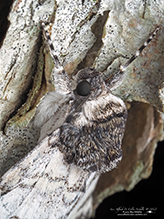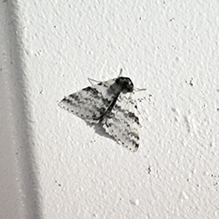white underwing
(Catocala relicta)
Conservation • Description • Habitat • Ecology • Distribution • Taxonomy
|
||||||||
| Hodges # | 8803 |
|||||||
Conservation Status |
||||||||
| IUCN Red List | not listed |
|||||||
| NatureServe | NNR - Unranked SNR - Unranked |
|||||||
| Minnesota | not listed |
|||||||
Description |
||
White underwing is a medium to large sized underwing moth. Adults are 1 7 ⁄16″ to 1⅞″ in length and have a wingspan of 2⅝″ to 3″. Males and females are identical in appearance. The forewings are white with a dusting of gray and dark gray scales. The amount of dark scaling varies greatly between populations—in some population the forewings are mostly white, in other populations they are mostly dark gray. They are crossed with several jagged, light to dark gray lines, including a broad median line. The median line passes through a kidney-shaped (reniform spot) spot in the lower median area. The reniform spot is dark gray and may have some light spots. The smaller circular spot closer to the inner margin (subreniform spot) is white and outlined with gray. A line nearest to the outer margin (terminal line) consists of row of dark gray spots between the veins. The fringe is light gray. The outer margin of the forewing is scalloped. The hindwings are black with a broad, curved, white median band, a narrow white stripe near the margin, and a white fringe. The thorax is dark gray. There is a prominent tympanal hearing organ on each side of the thorax. The antennae are slender and thread-like. The caterpillar is whitish and about 3″ in length. There is a dark gray, saddle-like band partially covering the fifth and sixth abdominal segments (A5 and A6). The band extends to the leg-like appendage (proleg) on both segments. The breathing openings (spiracles) are black with a narrow white border. There is a fringe of numerous, long, hair-like growths (setae) near the base (subventral area) of each segment. The head has a dark band across the top and dark mottling near the triangle (frons). Mature caterpillars are found from late June to early July. |
||
Size |
||
Total length: 1 7 ⁄16″ to 1⅞″ Wingspan: 2⅝″ to 3″ |
||
Similar Species |
||
| This is the only underwing with a white band on the hindwing. | ||
Habitat |
||
Deciduous forests, especially aspen forests |
||
Ecology |
||
Season |
||
One generation, July to mid-October |
||
Behavior |
||
Adults are nocturnal and are attracted to light. |
||
Life Cycle |
||
The eggs overwinter and hatch in April or May. |
||
Larva Hosts |
||
Mostly quaking aspen (Populus tremuloides), but also willows (Salix spp.) and other cottonwoods and poplars (Populus spp.) |
||
Adult Food |
||
Flower nectar |
||
Distribution |
||||
|
Sources |
|||
| 12/25/2022 | ||||
Occurrence |
||||
Common in Minnesota |
||||
Taxonomy |
|||
Order |
Lepidoptera (Butterflies and Moths) | ||
Superfamily |
Noctuoidea (Owlet Moths and Allies) | ||
Family |
Erebidae (Underwing, Tiger, Tussock, and Allied Moths) | ||
Subfamily |
Erebinae (underwings, zales, and related owlets) | ||
Tribe |
Catocalini | ||
Genus |
Catocala (underwing moths) | ||
Subordinate Taxa |
|||
Catocala relicta elda was formerly considered a subspecies, but is now treated as a synonym of Catocala relicta. |
|||
Synonyms |
|||
Catocala elda Catocala relicta elda |
|||
Common Names |
|||
the relict white underwing |
|||
Glossary
Frons
The upper front part of an insect’s face, roughly corresponding to the forehead.
Proleg
A fleshy structure on the abdomen of some insect larvae that functions as a leg, but lacks the five segments of a true insect leg.
Reniform spot
A kidney-shaped spot or outline in the lower median area near the PM line on the forewing of many moths.
Seta
A usually rigid bristle- or hair-like outgrowth on butterflies and moths used to sense touch. Plural: setae.
Spiracle
A small opening on the surface of an insect or arachnid through which it breathes.
Tympanum
An external hearing structure. In reptiles and amphibians, the circular, disk-like membrane that covers the ear opening. In insects, the membrane covering the air sac and sensory neurons. Plural: tympani.
Visitor Photos |
|||||
Share your photo of this insect. |
|||||
| This button not working for you? Simply email us at info@MinnesotaSeasons.com. Attach one or more photos and, if you like, a caption. |
|||||
Alfredo Colon |
|||||
 |
 |
||||
JDenby |
|||||
 |
|||||
Amanda Wilkins |
|||||
 |
|||||
Norm & Peg Dibble |
|||||
Moth in St Cloud |
|||||
 |
|||||
Nicole Vasquez |
|||||
| Not the best picture but noticed there was not one on the site. Found on the side of building in resting position. |  |
||||
MinnesotaSeasons.com Photos |
|||||
|
|||||

Slideshows |
||

Visitor Videos |
|||
Share your video of this insect. |
|||
| This button not working for you? Simply email us at info@MinnesotaSeasons.com. Attach a video, a YouTube link, or a cloud storage link. |
|||
Other Videos |
|||
| White Underwing Moth - Catocala relicta wetvideocamera |
|||
About
Published on Sep 11, 2012 White Underwing Moth, a Noctuid moth with black underwings and white bands across them. Seen at Barnet Marine Park, Burnaby, BC ( Catocala relicta ) September 11, 2012 |
|||
| White Underwing Moth (Erebidae: Catocala relicta) Dorsal View Carl Barrentine |
|||
About
Published on Aug 28, 2011 Photographed at Fisher, Minnesota (28 August 2011). Thank you to Maury Heiman (@Bugguide.net) for confirming the identity of this specimen! |
|||
| Catocala relicta wetvideocamera |
|||
About
Published on Nov 16, 2013 White Underwing Moth or Relict seen at Barnet Marine Park, Burnaby, BC September 11, 2012 |
|||


Created 9/24/2017
Last Updated:





